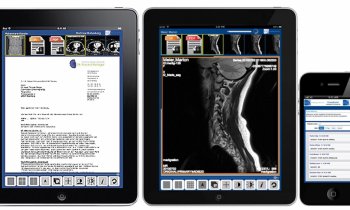Obama plans to digitise medical records within five years
Karen Dente reports from the US
The healthcare sector has been surprisingly slow in adopting information technology when compared to other industry sectors. In the United States, health information technology (HIT) is now being considered by many involved in the re-organisation and improvement of the quality of healthcare as a powerful tool with the dual potential to save lives and reduce healthcare costs.
Both political parties in Congress have expressed a strong interest in HIT and a fiscal stimulus law passed earlier this year provides $19 billion for the creation of a national health information network. Obama's plan is to digitise medical records within five years.
A 2005 analysis by the RAND Corporation, an American think-tank, examined the benefits of making healthcare records digital. It reported that $77 billion could be saved annually from gains in efficiency, although the study has been disputed. Another study published this January in the Archives of Internal Medicine compared a group of hospitals in Texas that had integrated advanced HIT systems with a group that has not; it found that the first group had a much lower incidence of mortality and complications.
Despite reports that indicate that computerising prescribing orders and drugs can cut medication errors that result in lost lives and increase morbidity, physicians across the US have been slow to adopt electronic systems. According to a study published in the New England Journal of Medicine, since 2006 only 13% of physicians and 11% of hospitals nationwide are utilising HIT, with 83% of physicians having no access to functioning electronic health systems (EHS). Findings were based on a survey conducted from 2007 to 2008. While 13% of doctors utilised a basic functioning EHS, only 4% were found to have access to a fully functional system. In addition, of the 83% with no functioning EHS, 17% had purchased a system that was not yet plugged in, with 26% thinking of plugging it in within the next two years. Regardless of the fact that few doctors were using the system, those who did reported that it positively affected the quality of healthcare delivered on many levels, in particular by increasing the quality of communication with patients and other providers and avoiding medical errors, with care delivered increasingly meeting evidence-based guidelines.
One barrier to adoption of HIT cited by many physicians is concern about the legality of sharing information of hospital donated medical records and the possibility of illegal tampering and inappropriate disclosures. Many physicians are looking for a financial incentive to adopt an IT system in the form of additional payments. Perhaps a way of contributing to greater adoption by physicians would be to make the liability of not adopting higher than the liabilities of adopting these systems, Sara Rosenblum suggested at a forum earlier this summer on the future of HIT sponsored by the Robert Wood Johnson Foundation, one of America's leading philanthropic organisations devoted to healthcare. Ms Rosenblum chairs the Department of Health Policy at George Washington University School of Public Health and Health Services. The RWJF has committed $300 million over five years to help 14 communities adopt quality improvement pilot schemes centred around IT, according to Dr John Lumpkin, Senior Vice President of the Foundation and director of its healthcare group.
Ms Rosenblum cited studies that have pointed out the low international performance in the US compared to other countries with respect to patient safety. There has been a failure in adults and children to get recommended treatment, with children especially faring worse, due to a failure to disperse information related to promising interventions rapidly. This results not only in inadequate healthcare but also excessive costs to the health system.
The benefits of IT span clinical implications on an individual patient level as well as broader public health implications. On an individual patient level it functions as a key tool to increasing efficiency and providing more timely information to access to clinical treatment options. On a broader public health level, IT can be an integral component in registries of people with chronic disease, e.g. diabetes, or population registries tracking the extent of immunisation among children, for instance. ‘The public health implications of information technology are every bit as important as the clinical implications,’ says Sara Rosenblum. It can inform public policy and combat the social ills of obesity and diabetes. Having connections between clinical care system, public and population healthcare systems would go a long way to making information more transparent for the treating clinician and improving primary care delivery.
Up to 30% of healthcare costs ($700 billion) delivered in the US do not improve outcome, according to Peter Orszag, Director of the Congressional Budget Office who has overseen the Congressional Health Budget Office since January. One of the key drivers behind rising health costs is due to the adoption of technology, some of which has been applied to negative value settings without improving quality, he believes. He warned of simply implementing IT systems within what he calls ‘a fragmented system with distorted financial incentives that leads to more care rather than better care’. There is a need for processing the information gathered via IT in an efficient way. One big driver of healthcare costs that has been touted by many experts is that there is insufficient measurement of what works and what doesn't, leading to much unnecessary costs due to care that is not required. Comparative effectiveness analyses linked to the healthcare systems would be a step in the direction of gathering data to help with assessing useful healthcare versus redundant care and might lead to a reduction in healthcare dollars spent.
Some of the limitations of making medical data electronic revolve around concerns over privacy and ownership. Does the patient or the provider own the records? While health records are controlled by providers who create the information, patients under the HIPPA (Health Insurance Portability and Accountability Act) laws have a right to access their personal medical information and to copy that record. As patients begin to want to populate their own medical records, the distinctions as to who owns the record begins to blur with potential concern about loss of control over one's property from the patient perspective, an important social phenomenon to be considered. Increased control over who sees their medical records can place patients on a more equal footing with decision-makers.
The two major software vendors, Microsoft and Google, are not covered under the HIPPA laws, which may lead to privacy and security concerns for patients. This means that any entity that does not deliver healthcare and that creates a personal health record is not required to give the same levels of protection to safeguard patient privacy as those that are covered under HIPPA. Dr Collen, of Kaiser Permanente, is convinced that HIT will only succeed if it is coupled with empowerment of the patient who has lived with a medical problem and often knows it better than the doctor. One hospital in New York has started a pilot scheme of electronic healthcare records using Microsoft's Health Vault software that gives full control to patients for deciding what part of their medical records they can share with whom.
One of the challenges of integrating HIT into the current system is that, besides Medicare, which covers the elderly above 65 years, there are multiple payments systems, so it is very difficult to integrate IT with more than one payment system. There is also concern expressed by the Medical Institute of Medicine that the big software vendors might slow things down for their own profit when ensuring that systems work together seamlessly. Medical information must move freely about on rival software systems, according to the Medical Institute of Medicine to prevent the danger of a too monolithic approach.
While IT is an enabling tool to facilitate timely access regarding choices to clinical treatment, it is not a solution to all errors and salient concerns such as privacy remain to be resolved before widespread implementation.
19.11.2009










